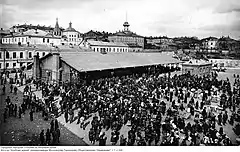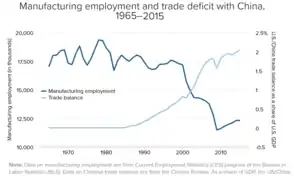Unemployment in China
Unemployment has been a serious social issue in China in recent years, in regards to both an increase in quantity and its unequal impact on different social regions. The influence of foreign investment in China has greatly increased since the Open Door Policy was implemented in the early 1980s. The relationship between foreign-funded enterprises and urban labor market development is dual. Opponents influence the shape of labor-market regulation; But foreign-funded enterprises have also become a major source of demand for urban and rural areas migrant workers. The exploitation of China's labor force by foreign-owned enterprises leads to the shortage of domestic enterprises’ labor force. Demographic factors also effect unemployment in China; for example, age - young, middle-aged and elderly workers have different experiences; also the position of women in the labor market has been deteriorating, with a decline in labor force participation rate, rising unemployment, increase intensity of work and a widening gender pay gap.[1]
 Mass unemployment | |
| Duration | Economic development period |
|---|---|
| Location | China |
| Type | Economy |
| Budget | Reduce unemployment |
| Outcome | Economic impact |
Rural Labor Migration and Urban Unemployment

The unemployment rate in every country throughout the world are powerfully related with Gross domestic product and rural and urban labor. Official government statistics show that unemployment in China is unusually low relative to gross domestic product and suspiciously stable. China's labor market was highly regulated and dominated by state-owned enterprises, with an average of 3.7 per cent, but this rose sharply during the numerous lay-offs between 1995 and 2002 and average 9.5 per cent in the three years between 2002 and 2009. Then unemployment rate fell throughout the period, particularly between 1995 and 2002. These changes had the greatest impact on non-technical workers from rural area. Particular less educated women and the younger. Lastly, estimates of unemployment and labor force participation rates were provided for all urban residents, including migrants without registered permanent residence.[2] As on 2018, the total number of registered migrant workers stand around 288.4 million.[3][4]
Furthermore, urban and rural unemployment rate and China's accession to the WTO has a certain relationship. WTO refers to an international institution that oversees the global trade rules between nations. "The WTO is based on agreements signed by the majority of the world’s trading nations. The main function of the organization is to help producers of goods and services, exporters, and importers protect and manage their businesses".[5] From the result of Wang, Z and Zhai, F, there is a huge need for coordination between China's rural-urban migration policy, labor market reform and the trade liberalization measures after China access to the WTO. If China relaxes its control over the flow of urban and rural population, the net benefits of WTO will be maximized. This action would not only prevent a deterioration in urban unemployment, but also increase the flexibility in the labor market to create more employment opportunities for the rural unskilled labor workers from the agricultural sector.[6]
Global economic crisis on the unemployment

Since October 2008, migrant workers have been returning home as the result of Financial crisis of 2007–2008 restrained consumer demand in developed countries and export orders for Chinese goods dried up. The financial crisis can be defined as prices fell sharply, businesses and consumers were unable to repay their debts and financial institutions ran short of liquidity. “Other situations that can be defined as financial crisis include the bursting of speculative financial bubbles, stock market crashes, sovereign debt defaults, or currency crisis".[7] These extraordinary groups known as the “rural migrant labor” is China's “special forces” and its comparative advantages as the “workshop of the world”. Migrant workers are not only the hard core of Chinese manufacturing but also the foundation of global supply chains. This means the pace of the global economy is tightly integration with China's migrant workers. Indeed, even before the global economic crisis, China's large number of migrant workers were already socially and legally marginalized. So, the recession has result in a variety of migrant unemployed in many parts of the world. The size of the migrant workers in China makes the enormous scale of poverty created by the recession shocking. According to the research, at the beginning of 2009, the number of unemployed immigrants exceeded 20 million, accounting for about 40% of the total population who lost their jobs. There is no doubt that global economic crisis has a crucial impact on unemployed. This mass unemployment experienced by the social group makes it the biggest victim of the global financial crisis.[8] In addition, in the following months after August 2008, china's orders by exports were declined sharply and especially in coast cities. Most of the pearl river delta business closed and got into a property problem. This would result in fresh college graduates cannot search for suitable jobs and decrease the participation rates in the labor force market. There is no denying the fact that global financial crisis and economic recession have affected rural areas. The migrant workers are far worse off than any other social group in China and the unemployment rate is at an all-time high at the start of 2009. However, the government has been providing assistance to the unemployed and responsible for stabilizing the unemployment situation of urban registered permanent residence population to increase employment opportunities.[9]
State capacity and governance issues to tackle unemployment
With the seriousness of the unemployment rate in China, the government have some policies to deal with unemployment. Policies to address unemployment and assist the unemployed are important national capabilities and governance. Despite the high level of economic growth, the restructuring of the economy has resulted in an increase in urban unemployment over the past decade, which has become a sensitive problem and a civil unrest in many cities. Since 1986, and especially since 1997, the central government's unemployment policy has focused on helping cities and towns register the unemployed and “laid-off workers” through unemployment insurance, reemployment service centers and employment services such as training and employment assistance. These efforts are aimed at controlling in layoffs and job creation in state-owned enterprises by stimulating economic growth.[10] At the same time, the Chinese government is committed to promoting employment and industrial structure through boosting the national economy, adjusting the economic structure, advancing the reform of the political and economic system, balancing urban and rural economic development, and continuously increasing the social security system. All these policies are in order to keep the stable unemployment rate within the tolerable range of society. The government would also utilize monetary policy, taxation and fiscal policy to reduce unemployment. Using favorable taxation policy, the government support the unemployed to achieve self-employment or set up their own businesses. Meanwhile, encourage small and medium size companies to absorb the unemployed. Governments provide small loans and give interest subsidies to support the businesses and support SME's development for the sake of expanding employment. The government would also establish social security policy to improve the unemployment. In the mid-1980s, china established the unemployment insurance system, which provides unemployment benefits and medical insurance subsidies to the unemployed. This social insurance policy stimulates SME's to employee unemployed.
Lastly, the government actively cultivate and develops the labor market. From the late 1990s, Chinese government has endeavor to build of scientific, standardized and modernized labor market, and constructed a public employment service system. “All levels of public employment service would provide free job placement and employment guidance to the urban unemployed and rural migrant workers. Providing a “one-stop” service ranging from registration of laid-off and unemployed population looking for jobs, job placement, social insurance coverage, and vocational skill training”. Through improving information system of labor market, the Chinese government offer convenient information services for job seekers and enterprises so that enhance the efficiency in labor market supply and demand matching.[11]
Youth unemployment
Teenagers form a large part in China, so the Youth unemployment rate also affects the economic development of China. In the past, a low-skilled young population found it easy to find a job, but with economic stagnation, they might face increasing difficulties in seeking or maintaining jobs. Additionally, as these jobs tend to be low-paid and with little social security like unemployment welfare and insurance, these young workers face various forms of social hardship and this has an effect on the progress and growth of society. At the same time, many graduates cannot compete for jobs with top university graduates, they are not willing to take low-quality, low-paid jobs. These so-called “neet group” would rather stay at home and rely on their parents to survive than to work. Most parents encourage this behavior, because many parents have to keep low-skilled jobs to seed their children to college, so they cannot accept their children will end up doing the same job as them. In this respect, this group waste their job opportunity cost and result in youth unemployment issue in China.[12] Furthermore, in the recent labor market, the unemployment issue among the young generation is structural unemployment, this results from a mismatch between the nature of job conditions and the skills. At the same time, college graduates cannot find a job because of the teaching and learning environment in 1999. According to the research, there are 750,000 college graduates could not find a job upon graduation, the number sharply increased to 1.2 million in 2005, and nearly 2 million in 2009. The real numbers might be higher than official data.[13] However, not every college graduate is unable to find a job, it depends on the reputation of the university. For example, the top ten university students in China are easily finding a high salary job comparing to other universities with a less known and inferior brand. Therefore, this reflects the disparity in education. The faculty level and environmental conditions of top universities are stronger than those of unknown universities. Moreover, it is difficult for many high school students to enter the top ten universities in China, so they can hardly compete with these students to find jobs after graduation.
References
- "Unemployment in China: Economy, Human Resources and Labour Markets, 1st Edition (Paperback) - Routledge". Routledge.com. Retrieved 2019-05-13.
- "ScienceDirect". www.sciencedirect.com. Retrieved 2019-05-13.
- cycles, This text provides general information Statista assumes no liability for the information given being complete or correct Due to varying update; Text, Statistics Can Display More up-to-Date Data Than Referenced in the. "Topic: Employment in China". Statista. Retrieved 2020-12-02.
- "China Labor Market - Changes and Trends". HROne. 2020-07-06. Retrieved 2020-12-02.
- Sandra Lim. "Learn More About the World Trade Organization – WTO". Investopedia. Retrieved 2019-05-31.
- Zhai, Fan; Wang, Zhi (2002-11-01). "WTO Accession, Rural Labour Migration and Urban Unemployment in China". Urban Studies. 39 (12): 2199–2217. doi:10.1080/0042098022000033827. ISSN 0042-0980.
- Kenton, Will. "Financial Crisis". Investopedia. Retrieved 2019-05-31.
- Chan, Kam Wing (2010). "The Global Financial Crisis and Migrant Workers in China: 'There is No Future as a Labourer; Returning to the Village has No Meaning'". International Journal of Urban and Regional Research. 34 (3): 659–677. doi:10.1111/j.1468-2427.2010.00987.x. ISSN 1468-2427.
- Cai & Chan, Fang & Kam Wing (2009). "The Global Economic Crisis and Unemployment In China" (PDF).
- Duckett, Jane; Hussain, Athar (2008-04-24). "Tackling unemployment in China: state capacity and governance issues" (PDF). The Pacific Review. 21 (2): 211–229. doi:10.1080/09512740801990279. ISSN 0951-2748.
- DI, Yan (2019). "China's Employment Policies and Strategies" (PDF).
- Esposito, Terence Tse and Mark (2014-02-20). "Youth unemployment in China: A crisis in the making". www.cnbc.com. Retrieved 2019-05-13.
- Huang & Zhao, Yanjie & Litao (2010). "Unemployment Problem Of China's Youth" (PDF).
 |
| Life in the People's Republic of China |
|---|